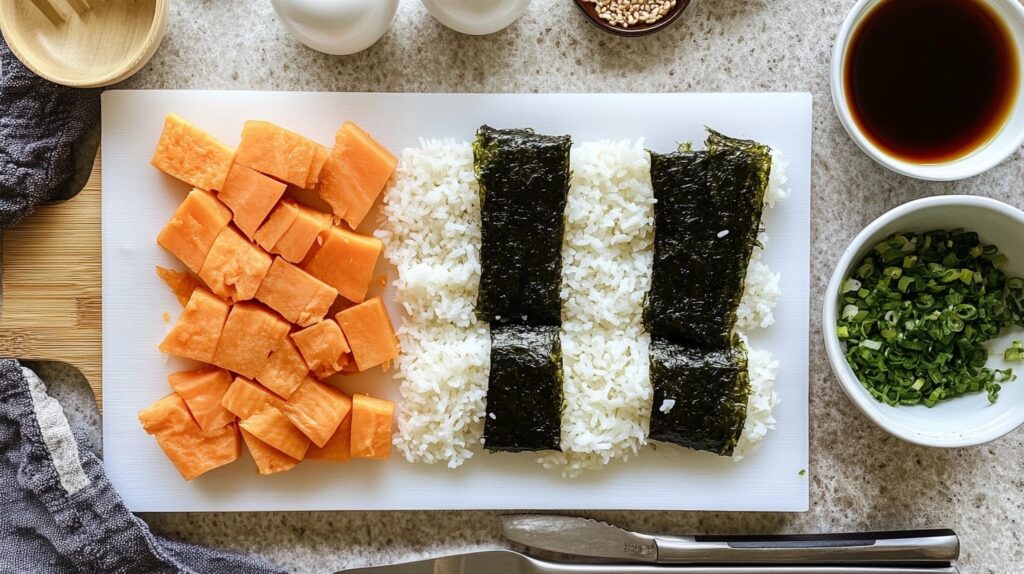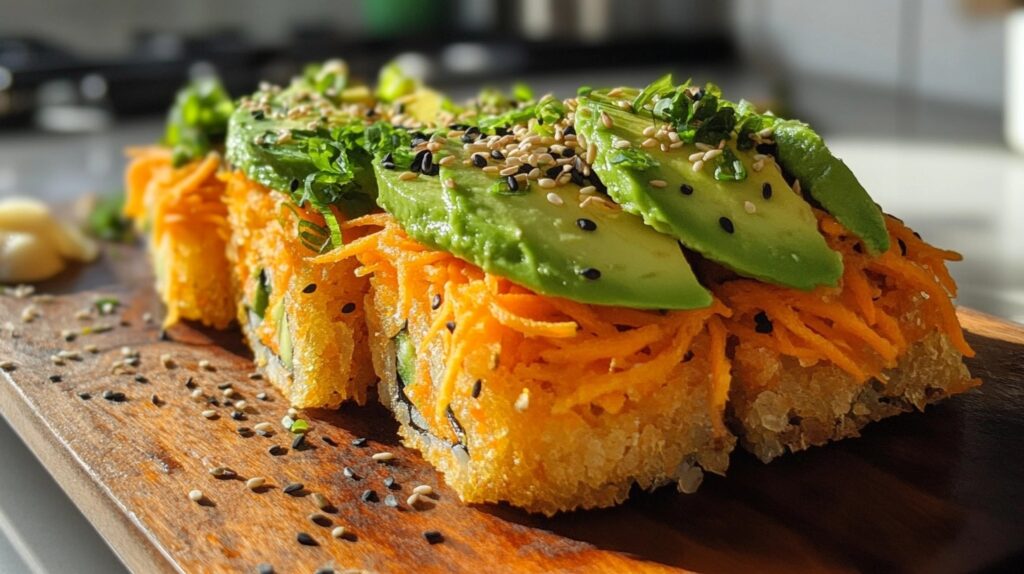Introduction
Is sweet potato tempura roll healthy? Sweet potato tempura rolls have become a favorite in sushi menus worldwide. Their vibrant colors, crispy texture, and unique flavors make them a standout vegetarian option. But are sweet potato tempura rolls healthy? That’s the question we’ll explore in this article. From their nutritional profile to their potential benefits and downsides, we’ll delve into the science behind these rolls while offering tips for making them a healthier choice. Let’s dive into the delicious details!
What is a Sweet Potato Tempura Roll?
Sweet potato tempura rolls are a creative twist on traditional sushi rolls. They combine crispy, fried sweet potato wrapped in seasoned rice and seaweed (nori), often with a drizzle of sauce for added flavor. This dish is typically vegetarian, appealing to both sushi lovers and those seeking plant-based options.
The star ingredient, sweet potato, provides natural sweetness and a soft, creamy texture that contrasts beautifully with the crispiness of the tempura batter. These rolls are often served as a main dish or appetizer, satisfying cravings with their balance of flavors and textures.
Focus of the Article: Health Aspects
When considering if a sweet potato tempura roll is healthy, several factors come into play. These include its nutritional profile, preparation method, portion size, and the specific diets it suits. While sweet potatoes are inherently nutritious, tempura frying adds calories and fats, which can affect overall healthiness. By examining these aspects, this article will offer valuable insights for those wondering whether these rolls can be part of a balanced diet.
Nutritional Profile of Sweet Potato Tempura Roll
To determine if a sweet potato tempura roll is truly healthy, we first need to analyze its nutritional makeup. Understanding what’s inside can help you make informed decisions about incorporating this delicious roll into your diet.
Main Ingredients and Their Nutritional Content
The primary components of a sweet potato tempura roll are sweet potatoes, sushi rice, seaweed (nori), and tempura batter. Each ingredient contributes unique nutritional benefits and challenges:

- Sweet Potatoes: Packed with beta-carotene, a powerful antioxidant, sweet potatoes are a great source of vitamins A, C, and B6. They also provide dietary fiber, which supports digestion and keeps you feeling full longer.
- Sushi Rice: Traditionally made with short-grain white rice, sushi rice is a carbohydrate source that provides quick energy but lacks significant fiber or protein. Brown rice can be a healthier substitute for added nutrients.
- Seaweed (Nori): Rich in iodine, iron, and magnesium, nori offers a mineral boost and is incredibly low in calories, making it a superfood ingredient.
- Tempura Batter: While it adds a satisfying crunch, tempura batter is high in fats and calories due to frying. Its nutritional impact depends largely on the oil used and the frying technique.
Calories and Macronutrients
A standard sweet potato tempura roll healthy typically contains:
- Calories: Around 250–400, depending on portion size and additional toppings.
- Carbohydrates: Approximately 40–50 grams, mainly from the rice and sweet potato.
- Protein: A modest 3–5 grams, as these rolls lack significant protein sources unless tofu or other fillings are added.
- Fats: About 10–15 grams, primarily from the frying process.
While the calorie count is reasonable for a meal or snack, it’s important to consider the higher fat content due to frying.
Micronutrients: Vitamins and Minerals
Thanks to the sweet potatoes and nori, these rolls offer a variety of essential vitamins and minerals:
- Vitamin A: Promotes healthy vision and skin.
- Vitamin C: Boosts immunity and supports collagen production.
- Magnesium and Iron: Found in nori, these minerals support bone health and oxygen transport in the blood.
Despite these benefits, the frying process may reduce some nutrient content. For instance, prolonged exposure to high heat can destroy vitamin C.
Health Benefits of Sweet Potato Tempura Roll
Although the sweet potato tempura roll is considered a treat for the palate, it also offers some surprising health benefits. Let’s take a closer look at how its ingredients contribute to overall well-being.
High in Fiber: Benefits for Digestion
Sweet potatoes are renowned for being fiber-rich, which can help maintain a healthy digestive system. Fiber promotes regular bowel movements, prevents constipation, and supports gut health by feeding beneficial bacteria. A single sweet potato tempura roll, especially if paired with brown rice, can provide a significant fiber boost, keeping you fuller for longer and potentially aiding in weight management.
Moreover, fiber helps regulate blood sugar levels, making this roll a better option than heavily processed snacks or high-sugar desserts.
Rich in Antioxidants: Beta-Carotene
Sweet potatoes are one of the best sources of beta-carotene, a powerful antioxidant that the body converts into vitamin A. Antioxidants protect cells from damage caused by free radicals, reducing the risk of chronic diseases like heart disease and certain cancers. Additionally, vitamin A supports healthy vision, boosts immune function, and promotes skin health.
Pairing these antioxidants with other sushi ingredients, like seaweed, further enhances the nutritional profile. Nori is rich in polyphenols, which also combat oxidative stress.
Energy Boost from Carbohydrates
If you’re looking for a quick energy source, the combination of sweet potato and sushi rice provides a steady release of carbs. This makes sweet potato tempura rolls an excellent pre-workout meal or an afternoon pick-me-up. Unlike simple sugars, the complex carbohydrates in sweet potatoes break down more slowly, providing sustained energy without a crash.
For athletes or busy professionals, this balance of carbs and moderate fats can help fuel the body throughout the day.
Potential Downsides
While sweet potato tempura rolls offer numerous health benefits, there are also potential drawbacks that warrant consideration. Moderation is key to enjoying this dish without compromising your health goals.
Fried Component: Is Tempura Healthy?
One of the defining features of a sweet potato tempura roll is its crispy fried layer. However, frying, especially in certain types of oil, can increase the dish’s calorie and fat content. Tempura batter absorbs oil during cooking, which adds unhealthy saturated fats and potentially harmful trans fats if low-quality oils are used.
Consuming fried foods regularly has been linked to increased risks of heart disease, weight gain, and inflammation. While an occasional tempura roll won’t derail a healthy diet, frequent indulgence can be problematic, especially if paired with other high-fat or fried foods.
For a healthier alternative, some chefs and home cooks bake the sweet potato slices instead of frying them, preserving the taste and texture with far fewer calories and fats.
High-Calorie Count: Portion Considerations
Another downside is the calorie density of sweet potato tempura rolls, which can creep up when you consider the rice, batter, and sauces. A single roll may seem small, but its calorie count can rival a full meal.
Portion control is crucial, particularly for those monitoring their weight or adhering to a low-calorie diet. Adding soy sauce, spicy mayo, or eel sauce, while delicious, can significantly increase sodium levels and hidden sugars.
Impact on Blood Sugar Levels
Although sweet potatoes are a complex carbohydrate with a lower glycemic index, combining them with sushi rice (which has a high glycemic index) and tempura batter can lead to blood sugar spikes. This could be a concern for individuals with diabetes or those seeking to maintain stable energy levels.
Being mindful of portion sizes and balancing your meal with protein-rich sides, like edamame or tofu, can help mitigate these effects.
Comparing Sweet Potato Tempura Roll to Other Sushi Options
When it comes to sushi, there’s an abundance of choices—from traditional sashimi to creative fusion rolls. How does the sweet potato tempura roll stack up against other popular options in terms of health?
Vegetarian Rolls: A Healthier Alternative?
Vegetarian sushi rolls, like cucumber or avocado rolls, are often seen as lighter options. Compared to sweet potato tempura rolls, they are typically lower in calories and fat since they lack the fried component. For example, a cucumber roll averages 150 calories per serving, while a sweet potato tempura roll can range from 250 to 400 calories.
That said, sweet potato tempura rolls bring additional nutrients to the table. Sweet potatoes provide more fiber, antioxidants, and vitamins than many other vegetables used in sushi. Avocado rolls, on the other hand, are rich in healthy fats but lack the beta-carotene and other micronutrients that sweet potatoes offer.
Ultimately, both options have their merits. If you’re looking for fewer calories, stick with simple vegetarian rolls. If you want a more nutrient-dense choice, sweet potato tempura rolls can be a worthy indulgence.
Traditional Sushi vs. Tempura Rolls

Traditional sushi, such as tuna or salmon rolls, is often regarded as a healthier choice because it’s high in protein and omega-3 fatty acids. These nutrients support muscle repair, brain health, and cardiovascular function. However, seafood-based rolls can also be high in sodium, especially when paired with soy sauce or other condiments.
Sweet potato tempura rolls, by contrast, are entirely plant-based, making them suitable for vegetarians. While they lack the protein found in fish, they’re a better option for those avoiding animal products. Moreover, they provide a unique combination of carbs, vitamins, and antioxidants that traditional rolls may not offer.
For the health-conscious, the choice between sweet potato tempura rolls and other sushi depends on dietary goals. Looking for protein? Opt for fish-based sushi. Want fiber and plant-based goodness? Sweet potato rolls are an excellent pick.
Is Sweet Potato Tempura Roll a Good Fit for Specific Diets?
One of the reasons sweet potato tempura rolls are so popular is their versatility. They can fit into various diets with some thoughtful adjustments, making them appealing to a broad range of eaters.
For Weight Loss Diets
If you’re trying to lose weight, sweet potato tempura rolls can be part of your meal plan, but portion control is crucial. While the fiber in sweet potatoes can help with satiety, the tempura batter and white rice add extra calories. To make it more diet-friendly:
- Opt for smaller portions or share the roll with a friend.
- Request brown rice instead of white rice for added fiber and slower digestion.
- Skip calorie-laden sauces, like spicy mayo, and go for lighter options like ponzu or plain soy sauce (in moderation).
By balancing your roll with a side of vegetables or a miso soup, you can enjoy this treat without exceeding your daily calorie limit.
For Plant-Based Diets
Sweet potato tempura rolls are a fantastic option for vegetarians and can easily be made vegan. They contain no animal products, provided the batter doesn’t include eggs or milk. If dining out, confirm with the restaurant to ensure their tempura batter is entirely plant-based.
For a nutrient boost, pair the roll with a side of seaweed salad or edamame. These additions provide protein and minerals, rounding out the meal while keeping it fully plant-based.
For Gluten-Free Diets
Traditional tempura batter often contains wheat flour, making it unsuitable for those with gluten sensitivities or celiac disease. However, gluten-free options are becoming more widely available:
- Look for rolls made with gluten-free tempura batter, or ask the chef to bake the sweet potato instead of frying it.
- Pair the roll with tamari, a gluten-free alternative to soy sauce, to keep the meal safe for gluten-free diners.
By making small tweaks, sweet potato tempura rolls can be adapted to fit nearly any dietary restriction, making them an inclusive and satisfying option for diverse preferences.
How to Make a Healthier Sweet Potato Tempura Roll
If you love sweet potato tempura rolls but want to enjoy them guilt-free, there are plenty of ways to make them healthier without sacrificing flavor. With simple swaps and tweaks, you can transform this indulgent dish into a nutritious delight.
Baking Instead of Frying
The most significant step in making a healthier roll is swapping the frying process for baking. Baking sweet potato slices achieves a similar crispy texture with far fewer calories and fats.
Here’s how to do it:
- Slice the sweet potato thinly and toss it with a small amount of olive oil, salt, and pepper.
- Bake at 375°F (190°C) for about 20–25 minutes until golden and crisp.
This method retains more nutrients, avoids harmful trans fats, and significantly lowers the dish’s overall calorie count.
Using Brown Rice for Added Fiber
Switching out traditional white sushi rice for brown rice is another excellent way to boost the nutritional value. Brown rice is higher in fiber, magnesium, and antioxidants, and it has a lower glycemic index, which means it won’t spike your blood sugar as quickly.
The nutty flavor of brown rice complements the sweetness of the potato beautifully. Plus, its chewy texture adds another layer of satisfaction to each bite.
Low-Calorie Sauces and Garnishes
While sauces like spicy mayo and eel sauce are popular additions, they can quickly increase calorie and sugar content. Opt for lighter, healthier alternatives:
- Use low-sodium soy sauce or tamari.
- Add a drizzle of ponzu sauce, which is citrusy and refreshing.
- Sprinkle sesame seeds or finely chopped scallions for extra flavor without unnecessary calories.
For those who love creamy textures, a dollop of Greek yogurt mixed with wasabi can be a lower-calorie substitute for traditional mayo-based sauces.
Bonus Tips for Homemade Rolls
Making sweet potato tempura rolls at home allows you full control over the ingredients. Consider these extra tips:
- Incorporate extra veggies, like julienned cucumber or bell peppers, for more fiber and crunch.
- Use a bamboo sushi mat to roll tightly and avoid wasting ingredients.
- Experiment with plant-based seaweed alternatives for additional variety.
By adopting these healthier methods, you can enjoy the delightful flavors of sweet potato tempura rolls while staying aligned with your health goals.
Conclusion: Is Sweet Potato Tempura Roll Healthy?
When it comes to answering the question, is sweet potato tempura roll healthy, the answer lies in balance and perspective. This dish, beloved for its combination of flavors and textures, has both pros and cons depending on how it’s prepared and consumed.
On the positive side, sweet potato tempura rolls are packed with nutrients, thanks to the sweet potato and nori. They offer dietary fiber, antioxidants like beta-carotene, and a range of vitamins and minerals. For vegetarians and plant-based eaters, these rolls provide a satisfying, nutrient-dense option.
However, the frying process and calorie density can detract from their health benefits, especially when consumed frequently or in large portions. Excessive oil and high-sodium sauces can also make them less ideal for certain diets, such as weight loss or low-sodium plans.
With a few simple modifications—like baking the sweet potato, using brown rice, and opting for lighter sauces—this dish can easily fit into a balanced diet. Whether you enjoy them as an occasional indulgence or a healthier homemade version, sweet potato tempura rolls can be both delicious and nutritious.
Ultimately, the key is moderation and making smart choices to adapt the dish to your dietary needs. With these strategies, you can savor this delightful roll without hesitation.
FAQs
Is sweet potato tempura roll vegan?
Yes, sweet potato tempura rolls can be vegan, but it depends on how the tempura batter is made. Traditional tempura batter often contains eggs or milk, so it’s essential to check with the restaurant or recipe. To ensure it’s vegan, look for rolls made with plant-based batter or baked sweet potatoes instead of fried.
How many calories are in a sweet potato tempura roll?
The calorie count for a sweet potato tempura roll typically ranges from 250 to 400, depending on the size, the amount of rice, and whether any additional sauces or garnishes are included. Using healthier preparation methods, such as baking and reducing sauce usage, can significantly lower the calorie count.
Is it okay to eat sweet potato tempura rolls every day?
While sweet potato tempura rolls are tasty and nutritious, eating them daily may not be ideal due to their fried components and higher calorie content. Incorporating them occasionally as part of a balanced diet is a better choice. For everyday consumption, consider opting for baked sweet potato rolls or other vegetarian sushi options.
Are there gluten-free options for sweet potato tempura rolls?
Yes, gluten-free sweet potato tempura rolls are possible! Traditional tempura batter contains wheat flour, but many restaurants and recipes now offer gluten-free tempura made with rice flour or other alternatives. Additionally, pairing the roll with gluten-free soy sauce or tamari ensures the dish remains safe for those avoiding gluten.
Can sweet potato tempura rolls help with weight loss?
Sweet potato tempura rolls can fit into a weight-loss diet when consumed in moderation. The fiber from the sweet potato can aid in satiety, but the fried batter and white rice may add unnecessary calories. Opting for baked sweet potato and brown rice is a smarter option for those aiming to lose weight.
Are sweet potato tempura rolls a good source of protein?
Sweet potato tempura rolls are relatively low in protein since they primarily consist of sweet potatoes, rice, and seaweed. Adding protein-rich sides, like edamame or tofu, or pairing the roll with other sushi options that include fish or plant-based proteins, can help increase the meal’s protein content.


2 thoughts on “Is Sweet Potato Tempura Roll Healthy? 5 Benefits, Nutrition, and Tips”